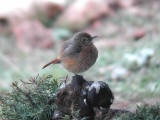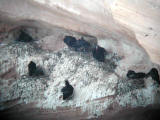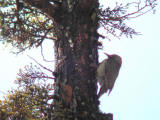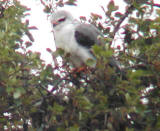Visit your favourite destinations |
| A Report from birdtours.co.uk |
Morocco 9th-18th April, 2004,
Lutz Lücker - Petit-Lancy/Geneva
Daniel Nussbaumer - Neuchâtel
Journey and weather
Since we had less than 10 days for a 3400 km trip, we spent a lot of time driving and observing, very little on photography. Weather was mostly dry, just a few drops at night in Merzouga and rain in Zeida on the evening/night of the 15th. The only drawback was the wind that was a bit too strong on every other day. We managed approx.160 species. Not bad in those circumstances.
We arrived in Casablanca airport and hired an air-conditioned Toyota Corolla from Hertz. Tyres a bit worn but no punctures on 150 miles track driving. Excellent 4-door car. Avoid choosing 3-door cars (when handling telescopes on tripods) and 5-door ones (boot easy to burgle)! NEVER leave anything "interesting" (=ANYTHING) on the car seats!
Route: roughly Casablanca-Agadir- Oued Massa -Taroudannt-Ouarzazate-Zagora (and back)-Boulmalne Dades -Tinerhir- Gorges du Todra -Touroug-Jorf-Rissani-Merzouga- Erg Chebbi Dunes -Erfoud- Er Rachidia -Rich-Midelt-Zeida- Col de Zad -Azrou-Ifrane-Mischliffen-Meknes-Rabat- Sidi Yahya Zaër -Casablanca.
Target species
Having never been to Morocco, our main goal was to see a wide variety of habitats and to take anything as a bonus. Due to the windy weather conditions we missed a few, mostly small birds like Fulvous Babbler, Mourning Wheatear, Desert and Tristram's Warbler, and dipped on others because we did not arrive at their stakeout at the right time of day (Pharaoh Eagle Owl, Double-spurred Francolin..). Well, one needs some reasons to come back..
What we did find were all the 14 lark species (including Dupont's, which we found within 10 minutes in broad daylight,) and 100+ Bald Ibis. So let's not complain! The only gen we could rely on were other trip reports we found on the internet. Alas, this has become all too easy which means more and more disturbance (for the Ibises and others.)! actually we did not see any uncommon birds for Morocco so this report is just a small supplement to all the others.
 |
Female Moussier's Redstart |
Itinerary
8th April
Missed the Oualidia road and found ourselves on the way to Settat. Went on to Khemis-Zemamra via Sidi-Bennour . Saw a few Collared Pratincoles there. Arrived at TAMRI , 60 kms north of Agadir shortly before sunset. First Bulbuls, African race Chaffinch and Pallid Swifts. And sure enough, soon there was a Bald Ibis flying across the fields and sand dunes. So we decided to stay put and did not regret it. More and more ibises came along, flying close by, one landing and feeding barely 50 yds away from us. A rare, antediluvian sight! You could actually see that birds do stem from dinosaurs! We saw a few people with bins going down to the shore and decided to have a look at what they were after. Soon, three 4-wheel drive cars overtook us, disappearing behind a dune. Some time later, a 4th Landrover with 2 policemen, who did not even look at us, arrived. Then, a flock of 30 Ibises appeared, whirling around the spot where the cars had been heading. A few yards further down the path we realized to our surprise (and dismay) that we had stumbled over the biggest colony in the world! The three Landrovers sped past us, the policemen and another plainclothes man went VERY close to the colony, disturbed the birds and talked amiably to a few people we had not seen before and then went back to the main road. We did not understand anything!
 |
Bald Ibis on the breeding ledges |
As it was getting dark we concentrated on the sand cliff where about 60 ibis pairs were rearing their (quite big) chicks, together with maroccanus Cormorants, Rock, Doves AND -surprise!- a Barbary Falcon on its 3 eggs! Finally, night falling, the reserve warden, who had been sitting just a few yards above the colony with the 3 other birders, told us to leave, what we did, being at least sure that we were the only people who had not deliberately disturbed the birds. Funny business!
 |
maroccanus Cormorant |
Night in Hotel Tivoli in Agadir with garden Bulbuls. Very nice but not very cheap.
9th April:
Early morning start to Oued Massa Reserve. Coffee at the hotel in Sidi Rbat, overlooking the beach with plenty of Audouin's Gulls and a few Kentish plovers. The first House Buntings and at least 4 Moussier's Redstarts in the area. A few Gannets off shore. No rare Terns along the shore so we made for the track along the river where a kind warden received us to show us a sunbathing Little Owl. Some way upstream, 29 Glossy Ibises, 1 Flamingo, 1 Spoonbill, 3 Marbled Duck. A pleasant, whistling song from the bushes reminded us that this was THE place for Black-crowned Tchagra. And there he was, sitting atop a bush in the strong breeze. Smashing bird! We were to hear 3 or 4 more, but invisible ones. We had the first of many Red-rumped Swallows, a Montagu's Harrier, 2 Night Herons, a few algeriensis Great Grey Shrikes, then we flushed 2 Barbary Partridges (poor views only.), and saw a lovely mauretanicus Magpie. 1 Squacco Heron near Massa village bridge. Went down to Taroudannt but saw nothing special due to the stormy winds. Night in Agadir with Audouin's Gulls seen from our balcony!
10th April:
Decided to make headway to Ouarzazate. Found a very dead Red-necked Nightjar on the road to Oued-Issène where we spotted a splendid Lanner Falcon pounding on some hapless bird. In Taroudannt, first Little Swifts, Pallid Swifts, more Red-rumped Swallows, White Storks, House Buntings. At the foothills 3 km north of the Igoudar T-junction, 1-2 Short-toed Eagles, 1 Long-legged Buzzard and the first Black Wheatear. But no Dark chanting Goshawks or Tawny Eagles! Near Oulad-Berrehil, we counted migrating 500 Black Kites in 20 minutes, and some time later, the whole Souss valley was crowded with those big birds struggling against the strong Atlantic winds. There must have been a "flock" of more than 1000, an unforgettable sight!
From the Aoulouz bridge we spotted .. 1 Spotted Crake, Crag Martins, Red-rumped Swallows, 1 Squacco Heron, 3 Booted Eagles. At Taliouine 1 Short-toed Eagle. West of Tazenakht first Red-rumped Wheatears (1 Black), north of the town the first singing Desert Larks. At dusk, in the oued 15 km west of Ouarzazate, approx.50 White Storks.
Night at (good but nightjarless) Hotel Le Zat.
11th April:
On the El Mansour dam road a family of 4 Black Wheatears + more Desert Larks. In a wadi and a village before Tizi-n-Tinififft pass (1660m) Tawny Pipits, Bonelli's Warbler and the first of many White-crowned black Wheatears. Just outside Agdz 1 Barbary Falcon, further SE 2 Blue-cheeked Bee-eaters chasing insects in the river bed, a lovely subpersonata White Wagtail, a singing contest of 3-4 Olivaceous Warblers, 1 Cetti's Warbler, and 30+ Rock Doves along the cliffs. 1 mile before Tanzikht a family of Barbary Ground Squirrel, a calling Barbary Partridge but no falcons!
 |
Blue-cheeked Bee-eater |
We drive through Zagora until the sand dunes of Tinfou where we choose the Porte du Sahara Hotel in the middle of the desert. Not expensive, off the main road, no need of a car to go birding. The German owner, having just bought an astronomic telescope, readily switches off the lights in late evening so that we can watch millions of stars. The sky is just unbelievable.
We hear a Stone Curlew, see 2 Desert Larks, a possible Brown Raven at the river 2 miles down the road. A White-crowned black Wheatear is the local housekeeper.
12th April:
Early morning start. We quickly find 3 Cream-coloured Coursers (1 with a fledged chick), 500 yds from the hotel, later another group of 11 by the dunes. Several Hoopoe Larks perform stunning display flights. The first Bar-tailed Desert Larks and the first (all female) Desert Wheatears. We drive back north where we find 4-5 roadside Trumpeter Bullfinches 1 km SE of Tazikht. Nice male Desert Wheatears on the N shore of the El-Mansour Lake with 1 Blue-cheeked Bee-eater. East of Skoura (km 45) 4-5 more Desert Wheatears, 2 Bar-tailed Desert Larks, 1 Tawny Pipit (still no eagles.)! At km 38, 1 or 2 Calandra Larks and more Desert Larks. At dusk we drive to the famous Tagdilt track after finding the Hotel Soleil Bleu (birding log!) in Boulmalne Dades. We spot our first Temminck's horned Lark and one of several Hoopoe Larks. But it is still too windy.
13th April:
Early morning start. We had to tell the staff at Hotel Soleil Bleu that we needed the doors (and gate) to be opened at 5.20h, otherwise we'd have been stuck inside!
Along the Tagdilt track (and the tarmaced road to Ikniounn) we hear several Temminck's horned Larks and Hoopoe Larks, a pair of which start mating while we watch...... A flock of 7 Crowned Sandgrouse (Pterocles coronatus) fly just over our heads, the only sandgrouse of the trip!
Suddenly, a bird on a rock turns out to be a stunning male Thick-billed Lark which even performs a few whistles of its extremely inconspicuous song. A Long-legged Buzzard is mobbed by two Northern Wheatears and there are more Desert Wheatears and Red-Rumped Wheatears. After breakfast we return to a parallel track that ends in a large pool of water from some irrigated fields. But we find an empty Hoopoe Lark's nest and spot 4-5 Montagu's Harriers one of which is a suberb male of the melanistic form.
Afternoon in the Gorges du Todra. Only a few Rock Doves, several Blue Rock Thrushes and commoner species. The first Nightingales in the exquisite palm groves of Tinerhir.
On our way to Rissani we pick up Nourdine El Jakani, a young Berber camel driver, who leads us to the Auberge Lahmada, a few yards from the famous Erg Chebbi dunes near Merzouga. He knows all the tracks by heart and we arrive at sunset without getting stuck in quicksand or breaking an axle. Nourdine knows the area like the back of his hand and can be contacted under eljakaninourdine@yahoo.com !
14th April:
After an unproductive but beautiful sunrise (just a few migrants like Subalpine Warblers, Bonelli's Warblers, Nightingales, speculigera Pied Flycatcher, Olivaceous Warbler and Wood Warbler in the shrubs and gardens behind the famous neighbouring Café Yasmina and our hostel we have breakfast with 2 Desert Sparrows that seem to be after our breadcrumbs.
Then we decide to take Nourdine with us to have a look at an Oasis and a lake. In a minute palm grove near the Café Erg Chebbi there are 7-8 more Desert Sparrows as well as a Brown-necked Raven. The oasis proves surprisingly unproductive (except for a few Palm Doves/Laughing Doves) but the Dayet Srij lake near Merzouga (good track from the last (pink) house of the village) holds 86 Flamingoes, 70 Marbled Teal, 160 Ruddy Shelduck, lots of Black-winged Stilt and there is an elegans Southern Grey Shrike in the shrubs. But no Desert Warblers! At sunset we are on the dunes again. But the only bird worth mentioning is.. a lone Ruddy Shelduck!
15th April:
 |
Desert Sparrow |
We return to Café Yasmina where we spot 1 female Desert Sparrow, a few migrants in the bushes as well as a fabulous Rufous Bush Robin which puts on a great show. We leave the area just in time,driving just ahead of a middle-sized sandstorm. On our way to Erfoud we see 3 more Brown-necked Raven near the track between Auberge Lahmada and Café Erg Chebbi. Near the end of Rissani village 2 Blue-cheeked Bee-eaters careen after insects in the palm grove; we see another one north of Erfoud. The blue source of Meski costs us a 5 Dirham parking fee for a few Olivaceous warblers, Cetti's Warbler and a second subpersonata White Wagtail. Around Er Rachidia, lots of European Bee-Eaters on migration, two very flat ones on the road. In the Gorges du Ziz we see a Peregrine type falcon (that might have been a Barbary, but no Tristram's warblers.Too windy!) After Tizi-n-Talrhemt pass it gets bitterly cold. We arrive in the steppe 2 miles S of Zeida 30 mins. before the sun disappears behind the clouds abouve the snow-covered High Atlas. My friend Daniel who is still wearing his desert outfit has to make a thorough change of clothes while I play the car radio tape recorder with Dupont's Lark. We drive on for a few minutes, come back to the same spot,.. and there it is, the mythical hide-and-seek bird, running across the road, perching on a grass cluster and singing its head off in broad sunlight! No more need to get up at five! We get a cheap but very modest room at the only "hotel" in Zeida (no hot water, tiny washbasin, shower drain clogged.) and a warm evening meal in one of the village's inns. Rain during the night.
16th April:
After breakfast we check on the Dupont's Larks at 9, and sure enough, there are still 3 singing males around with "our" bird performing exactly where we left our orange peels on the previous evening. They seem to be common birds in this area which also holds Lesser short-toed Larks and Red-rumped Wheatear.
 |
Northern (seebohm) Wheatear |
On we go and up into the Middle Atlas. Nothing special at the Aguelmane Sidi Ali but the large high plateau marshes between the lake and the Col de Zad pass abound with white Storks and Ruddy Shelduck. The area by the small lake 1 mile N of the pass holds Rock Sparrow, both Blue Rock Thrush and Rock Thrush, lots of beautiful seebohm Wheatears, Red-billed Chough, Peregrine, Atlas Shore Lark, and a Ruddy Shelduck family of 11.
we drive back to the pass and spend 2 hours looking for Levaillant's Woodpecker. A hard piece of work but we do find him on top of a Cedar-covered hilltop half a mile west of the pass. Several Moussier's Redstarts, stunning ultramarinus Blue Tits, Rock Bunting, and lots of coniferous wood species. But the most magnificent thing are the majestic Cedar giants, dead or alive!
 |
Levaillant's Woodpecker |
We continue towards Azrou (1 Booted Eagle) and find an even more cooperative Levaillant's Woodpecker on the far side of Dayet Aoua lake, 400 yds. before the entrance of a royal compound. Lots of (breeding) Crested Coot on the lake, and before we go to our Hotel Le Chamonix in Ifrane, we spot 6 Rollers on the wires along the road by the lake!
 |
Crested Coot family. |
17th April:
More than 200 miles to go back to Casablanca! Before breakfast, short stroll through Ifrane. There are Lesser Kestrels everywhere! More than 30! Pallid Swifts abound, ultramarinus Blue Tits in the alleys and a big Cattle Egret colony in one of the parks. On the way to Lake Dayet Iffer, 1 Booted Eagle and numerous Black Kites throughout the area. On the lake more than 100 ducks, mostly Shoveler, 50 Black-necked Grebes, 2 Ruddy Shelduck, numerous Crested Coot, some with chicks, 1 more Booted Eagle, 1 Long-legged Buzzard, Black Wheatear, Seebohm's Wheatear, a few waders, our only Spectacled Warbler.and 4 Wood-Pigeons! Some miles further, 1 Short-toed Eagle.
We drive towards the Tizi-n-Tretten pass (1934 m), get the first of many Woodlarks, 1 more Long-legged Buzzard; on the wires along the road to Mischliffen 4 more Rollers, Rock Bunting, as well as roadside Cirl Buntings. 2 miles before Lake Afenourir , 2 more Rollers, Skylark (!) and 3 more Long-legged Buzzards. Raptor day.! But we miss a right turn track towards the lake and then thick fog closes in on us..
 |
Black-winged Kite |
We choose to drive to Rabat as quickly as possible to get to the Double-spurred Francolin stakeout south of Sidi Yahya Zaër before dusk. 22 and 23 km before Rabat we spot 2 Black-winged Kites but cannot stop. Which was no real problem because when we arrived in the area between Sidi Yaha and Sidi Bettache (0.5-5 km south of the Skhirat t-junction) we had not only 2 but 3, then 4, and perhaps a fifth Back-shouldered Kite!!! One alighted in a tree and was mobbed (as we found out on our photos later) by a female Cirl Bunting. We also saw the 6th Long-legged Buzzard of the day, 2 more Booted Eagles, heard a Golden Oriole, and flushed 2 Barbary Partrige, but the Francolins remained invisible.
That was a splendid finale of an unforgettable trip.
Hotel in nightmarish downtown Casablanca, a few Little Swifts at the airport in the morning, and it's Bye-bye until the next time which - Inch Allah - is sure to come!
Why not send us a report, or an update to one of your current reports?